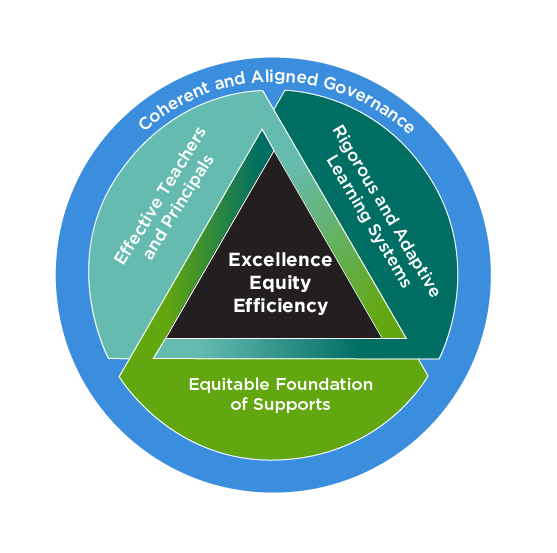The National Center on Education and the Economy (NCEE) is the leading U.S. organization studying high-performing education systems and their implications for dramatically improving American education. NCEE’s Blueprint for a High-Performing Education System (the NCEE Blueprint) distills our accumulated insights of more than 30 years of studying and benchmarking the world’s leading systems. The document organizes what we have learned and continue to learn from high-performing countries, provinces, states, districts, and schools about the ways they design their education systems to ensure that all students achieve at high levels.
The NCEE Blueprint offers a design that states or districts that want to match or exceed the performance of the world’s highest-performing systems can use as the conceptual framework for redesigning their own system. Simply adding discrete elements of this design to current systems is not sufficient. The elements must be implemented with an eye to how each connects with the others and fits together as a mutually supportive whole. It is the overall system design — adapted to the context of each specific education system — that must be constructed by the leaders with input from the entire community. State and/or district leaders must formulate how best to design each element, in concert with the other elements, to create a system in which each of these elements mutually reinforce each other to produce dramatically improved student learning at scale.
We encourage all educators and education policymakers to read and reflect on this document and to apply the learnings to their work. As you do, you will not be alone. In addition to our Center on International Education Benchmarking, whose research informs this document, NCEE is supporting a network of state, district and school leaders in tailoring and implementing the NCEE Blueprint through The Center on Policy Solutions and The Center on System Leadership.
The Challenge
Countries that redesign their education systems to achieve excellent student performance, equitably and efficiently, and to be adaptive to a future that is volatile, uncertain, complex, and ambiguous (VUCA) will likely enjoy high standards of living for years to come. Those that fail to do so, especially high-wage countries like the U.S., will struggle to compete and will face steadily widening income disparities, deepening inequities, and growing civil unrest.
This begs the question: how have so many other countries’ education systems gotten better results than the U.S., and what can our country do to exceed them and meet the challenges of an uncertain future?
For more than three decades, NCEE has been researching the answer to that question by identifying high-performing education systems around the world and the common elements they share. We define high-performing education systems as those that achieve excellence, equity, and efficiency: world-class levels of performance, for every student, at a sustainable cost. We compare these systems to the U.S. and to one another to better understand how they function as systems, the similarities and differences between them and the tradeoffs they have made. And we report on how they are changing to anticipate the future. The NCEE Blueprint is a distillation of that research.
A Blueprint for Systemic Education Redesign
Our research suggests that high-performing education systems have four components: Effective Teachers and Principals; a Rigorous and Adaptive Learning System; an Equitable Foundation of Supports; and Coherent and Aligned Governance. Within each component is a set of elements. Combined, they create a composite picture of a system that performs at world-class levels and that U.S. states and districts should aspire to match. But a system is more than the sum of its parts: the components have to reinforce one another. Effective teachers and principals activate the rigorous and adaptive learning system for students. An equitable foundation of supports ensures that teachers and principals can teach and lead effectively and that all students come to school ready and able to learn successfully. Coherent and aligned governance incentivizes each component to work in tandem, creates accountability for achieving results, and provides a structure to organize the system.
The most important feature of a high-performing education system is not that it contains all of these components. It is that the components are aligned and designed to work together as a system.
An Evolution of NCEE’s 9 Building Blocks
The NCEE Blueprint builds our 9 Building Blocks for a World-Class Education System that has guided NCEE’s work for years. The NCEE Blueprint continues to embrace the strong research basis behind the 9 Building Blocks, but reconfigures them in order to better represent the alignment between system components. It is also more explicitly about how systems achieve equity and efficiency alongside excellence. And finally, it updates the content with our latest research into the policies and practices of high-performing systems, conducted in the years since the 9 Building Blocks was written.
It is crucial that high-performing systems are dynamic and constantly evolving. They benchmark their performance against their peers around the world, respond to the latest research and advances in learning science, technology, and leadership theory, and work closely with theorists and economists to anticipate the challenges of the future. And so the NCEE Blueprint, like the previous iteration, is a living document that will continue to evolve as the high-performing systems do.
To learn more about how you can use the NCEE Blueprint to equitably and efficiently achieve world-class results in your district or state, contact us.


